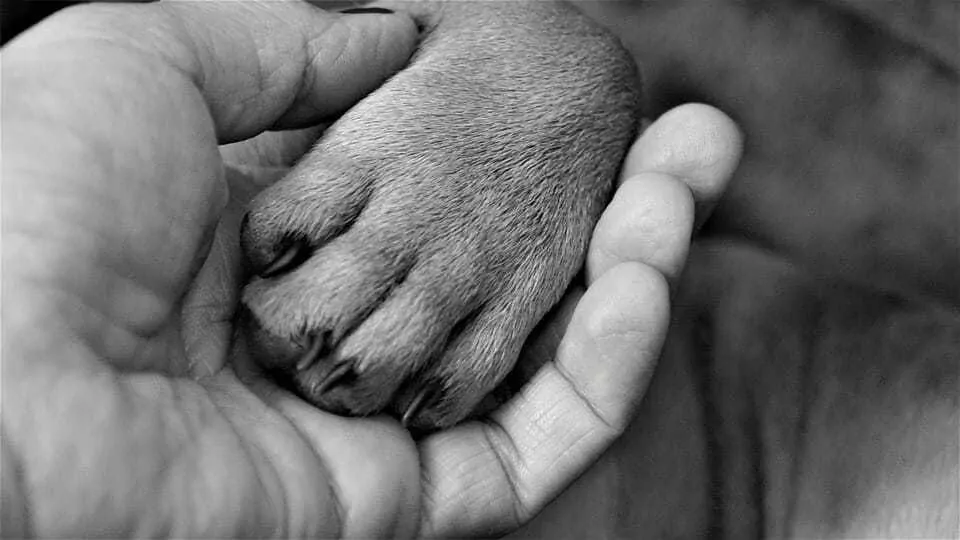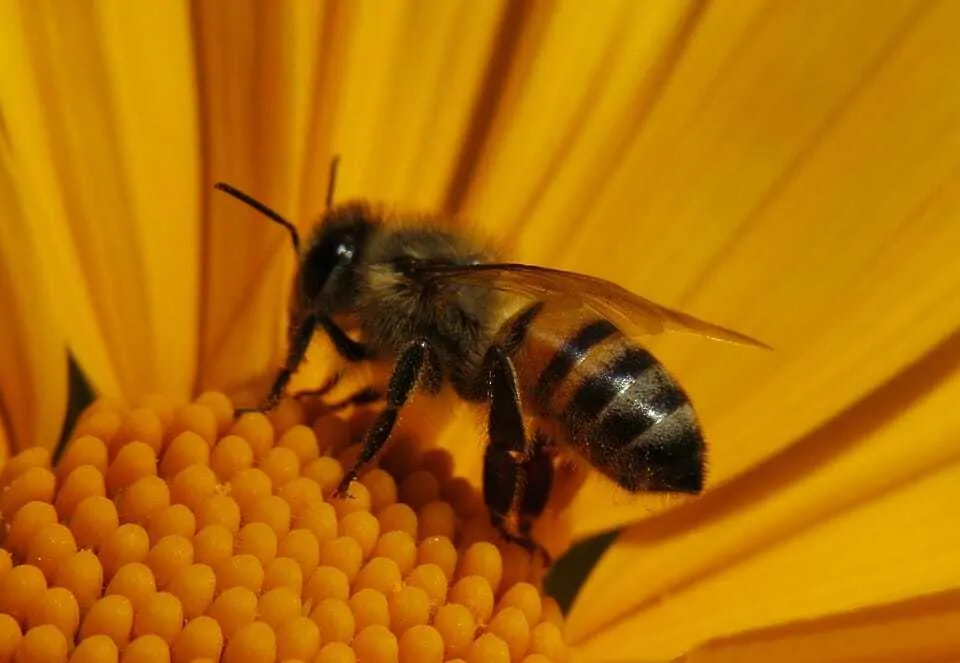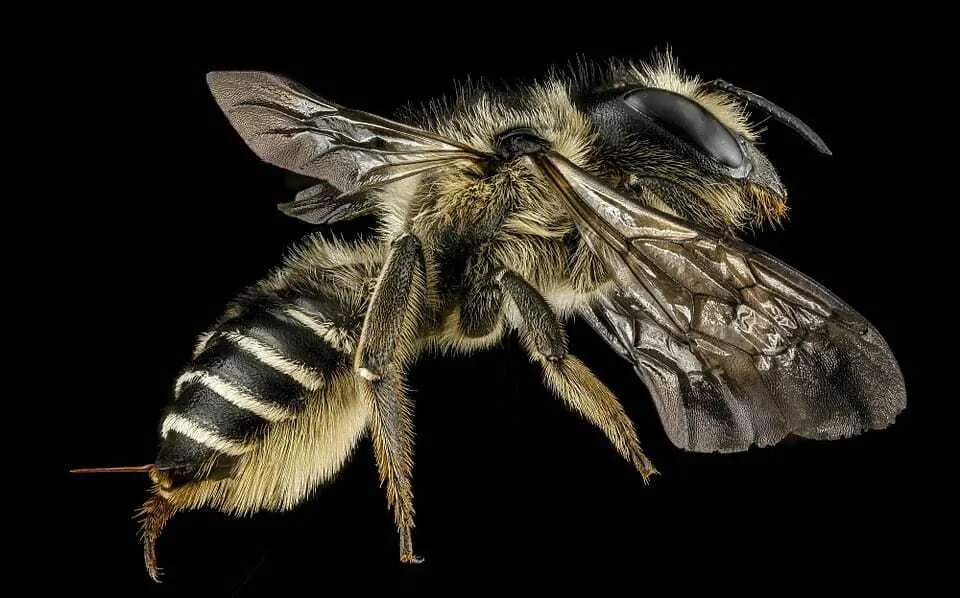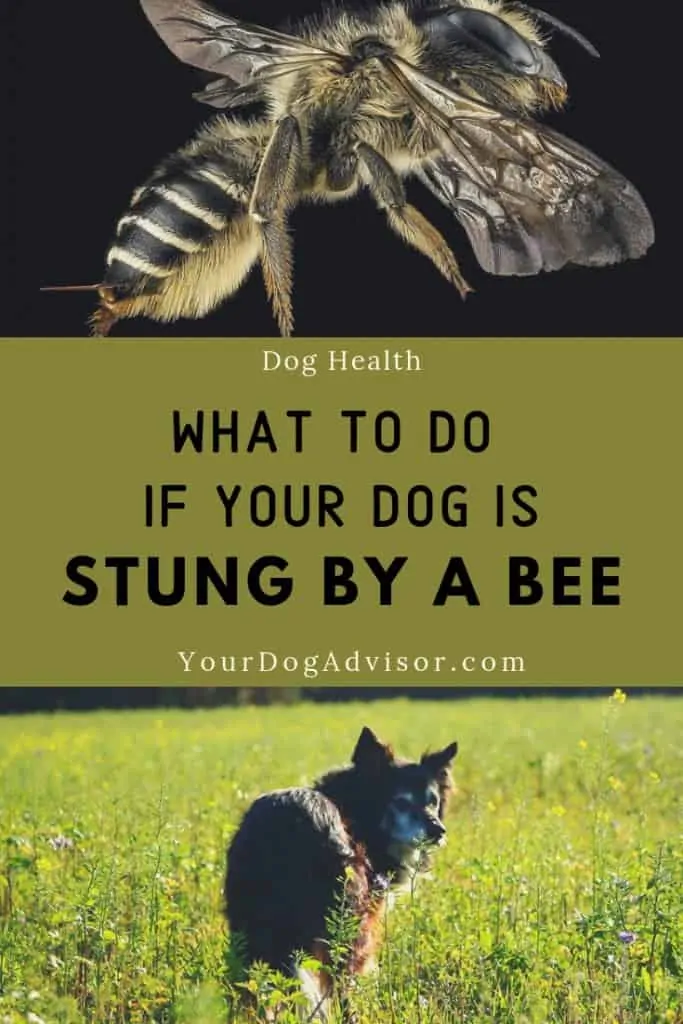Dogs are naturally innocent and curious creatures, and these are some of their best traits.
Unfortunately, these cute and endearing traits can also make the dogs we love vulnerable to injury, sickness, fleas, ticks, and even bee stings.
A bee sting can happen anywhere – on a camping trip, at the dog park, on routine walks or hikes, or even in your dog’s own backyard.
My dog was the victim of not one, but TWO bee stings in the last three months. She’s seven years old and has never been stung by a bee before in her life until recently.
So what gives?
Well, we moved to a place where she can be more active. We spend a lot more time outdoors, the weather is almost always sunny, and the flowers are almost always in bloom. (Shout out to the lovely state of California!)
And while California is great, it’s also the perfect habitat for bees. Lots of bees.
So, after two bee stings, two expensive vet visits, and two major panic attacks on my part, I’ve learned exactly what to do (and what not to do) when your dog gets stung by a bee.
But before I bestow this nifty knowledge upon you, let’s talk about some of the most common places your dog may get stung by a bee.
Contents
Where Is Your Dog Most Likely To Get Stung By A Bee On His Body?
Truth be told, your dog can get stung by a bee anywhere on his body, but there are a few more common places that dogs tend to get bee sting injuries.
On average, most dogs who get stung by bees get stung on their
- Face
- Nose
- Mouth
- And paws
Dogs most commonly get stung on their paws and noses.
I do want to note that while my dog was stung on the top of her paw the first time, she was stung on her neck the second time.
I’m not kidding. A bee swooped out of nowhere and stung her on the back of her sweet little neck while I was holding her. On a boat. In the middle of the ocean.
What the hell, bee?
Anyway, just be warned. A bee sting can pretty much occur anywhere and on any part of your dog’s body.
If You Don’t See Your Dog Get Stung By A Bee, How Will You Know He’s Been Stung?
To be fair, it’s not always going to be easy to determine if your dog has been stung by a bee until symptoms present themselves. This is because dogs are different and some dogs may scream in pain at a bee sting while others will hardly flinch.
My friend’s Pitbull was recently stung on her nose while in their backyard. She didn’t make a peep and had absolutely no reaction to the sting at all. We only knew the dog was stung because we saw it happen.
Another friend has a Bullmastiff mix who was stung recently as well, but they didn’t realize he had been stung until his face swelled the next day and they ended up having to take him to the vet.
And my dog, who has been stung twice now as I mentioned, reacted differently to both stings both times.
The first time my dog was stung by a bee, we were walking side by side through the dog park. She didn’t cry. She didn’t bark or yelp or whine.
So, how did I know she had been stung?
I was watching her and I saw her jump about three feet in the air. She then began running in circles and chewing on her paw.
I knew right away what had happened and, sure enough, after a bit of investigating in the grass where we were walking, I found the lone, (and sadly dying) culprit.
Due to our dogs’ curious natures, bee stings are quite common.
The second time my dog was stung she yelped a yelp I’d never heard her yelp. This, of course, grabbed my attention and I looked down to see a bee in the process of stinging her.
But it’s not always that easy. As I mentioned, all dogs react differently and you may not realize anything has happened unless you were watching at that exact moment.
The good news is that many dogs have very mild reactions to bee stings and some dogs have no reaction at all.
However, some dogs can be severely allergic.
That’s why I stress the importance of knowing your dog’s personality, energy level, and typical eating and bathroom habits when he is healthy. Usually, the first sign that something is amiss with your dog is a change in behavior.
I also encourage dog owners to know the symptoms of a serious reaction to a bee sting.
But before we talk about the symptoms of bee stings in dogs, let’s talk about what to do if catch the sting in action.
I Saw My Dog Get Stung By A Bee! Now What?
If you were lucky enough to see the sting as it happens, then the best thing to do is to act as fast as possible.
A bee sting allergy can occur in a dog at any time, even if your dog has been stung before and has never shown signs or symptoms of having an allergic reaction.
The good news is that the quicker you remove the stinger, the less of the bee’s venom is able to get into your dog’s bloodstream, meaning that you can actually reduce the severity of the reaction if you are able to remove the stinger quickly.
If you witnessed your dog get stung by a bee, it’s important to act quickly and remove the stinger.
If you witness your dog getting stung, don’t panic. Your dog will pick up on your energy and it’s important to keep him calm and still so you can safely remove the stinger.
But how do you properly remove a bee’s stinger from your dog? The answer may surprise you!
How To Properly Remove A Bee’s Stinger From your Dog.
If your dog is in pain from a bee sting, he may not want you messing with him. Still, it’s very important to try and remove the stinger as quickly as possible after the stinging incident has occurred to help reduce the severity of a possible allergic reaction.
While muzzles can make the removal of a stinger from your dog’s injured paw, nose, or mouth easier and safer, you may not always have one on hand.
If possible, have a trusted friend help you remove the stinger. If it is just not safe and you worry you’ll be bitten, wait until you know you can safely remove the stinger from your dog.
Now, are you ready to remove it? WAIT. Put the tweezers down!
Using tweezers or your fingernails to try and pluck the stinger out can actually cause the venom in the stinger to be pushed further into your dog’s bloodstream. Instead, follow these simple steps below.
Here’s how to properly remove a bee’s stinger from your dog.
- Use a credit card or something similar
- Gently pinch the skin with your fingers around the sting area to raise it slightly
- Scrape the stinger using the surface of the card, starting at the skin and moving upwards to remove it completely.
Use a credit card or something similar to scrape the stinger out of your dog.
Make sure you have removed the whole stinger from your dog’s body to ensure you have gotten rid of the source of venom and pain and to reduce any chances of infection down the road.
If you know your dog is allergic to bee stings, your next move should be to get him to the nearest vet immediately for treatment.
If you’re not sure if your dog is allergic to bees, watch him closely for the next two to twenty-four hours for symptoms.
Most Common Bee Sting Symptoms In Dogs
Luckily, most dogs have mild reactions to bee stings.
The most common symptoms of a bee sting in dogs can include
– Whining
– Yelping
– Running in circles
– Minor swelling of the stung area
– Limping
– Licking, chewing, or scratching at a particular spot on the body
– Salivating
– Mild lethargy
Some dogs have more severe reactions to bee stings than others.
If your usually active and energetic dog becomes somewhat lethargic or doesn’t seem himself after a bee sting but is still eating, drinking, and going to the bathroom regularly, don’t panic.
It’s normal for dogs to not feel very well after a bee sting. I would suggest just monitoring your pup closely for the next 24 hours and contacting your veterinarian to be safe.
Symptoms Of An Allergic Reaction
Like humans, a bee sting allergy in a dog is nothing to mess with and should be taken very seriously.
The most common signs of an allergic reaction to a bee sting occur within the first two to six hours.
However, and as mentioned above, some symptoms of an allergic reaction can present themselves much later.
In fact, my dog Axelle suffered an allergic reaction to her bee sting fourteen hours after contact and had to be rushed to the vet, so I would suggest keeping an eye on your four-legged friend for the next 24 hours following a sting just to be safe.
Allergic reactions to bee sting symptoms include
– Vomiting
– Diarrhea
– Severe lethargy
– Severe swelling
– Difficulty breathing
– Collapse
This video shows other ways to identify allergic reactions to bees. https://www.youtube.com/watch?v=5i8DA9wVVDg
If you notice any of the symptoms above in your dog after a sting, don’t wait. Get your dog to the vet immediately for treatment.
How Long Will The Symptoms Last?
When my dog got stung the first time, she wasn’t herself for a good three days. Granted, she was also on a pretty good dose of Benadryl to relieve her allergy symptoms.
The second time she was stung, I was able to remove the stinger immediately using the credit card process, and her reaction was much less severe. In fact, she hardly reacted at all.
Of course, all dogs are different.
Your dog may not feel like himself for a few days after a bee sting.
On average, the symptoms of a bee sting can last anywhere from a few hours to a few days.
If you feel that your dog is still showing signs of pain, lethargy, or mild swelling after about three days, I suggest giving your vet a call.
How To Help Ease Your Dog’s Pain
If you’re out and about and your dog gets stung by a bee, there are things you can do immediately that can make all the difference in the way your dog’s body reacts to the poison from the sting.
Along with immediately removing the stinger with a credit card or something similar, you can also apply a mixture of baking soda and water to the sting to help ease any pain. If there is any ice on hand, you can also apply ice to relieve the swelling.
The video below offers five remedies anyone can use at home to help ease their dog’s pain after a bee sting.
https://www.youtube.com/watch?v=mkTb50zp_20
You should also try to keep your dog from licking or chewing at the sting site as the area can easily become infected if not left alone to heal.
If you are having trouble keeping your dog from messing with his wound, you can always invest in a dog recovery collar.
To help keep your dog feeling calm and relaxed, you can give him calming supplements, have him to rest in a cool, dimly lit space where he feels safe, and even play relaxing music.
When To Take Your Dog To The Vet
Bee stings can be quite serious, especially if your dog is allergic.
You will want to pay close attention to your dog for the 24 hours after a bee sting to ensure he doesn’t have a severe reaction resulting in anaphylaxis.
Take your dog to the vet immediately if you notice
- Vomiting or diarrhea following a bee sting
- Difficulty breathing
- Severe swelling
-
- Disorientation
- Severe lethargy
- Collapse
If your dog is allergic to a bee sting, he may require immediate veterinary care.
If you notice your dog is exhibiting any of the symptoms associated with an allergic reaction to a bee sting, take him to the veterinarian immediately.
How To Protect Your Dog From Future Bee Stings.
Let’s face it. Your dog is a dog and he’s going to do doggy things and get into stuff and for that reason, you can’t completely eliminate his chances of getting stung by a bee.
With that being said, there are a few things you can do to help reduce his chances.
Along with having a dog-friendly first aid kit on hand, there are a number of important cues and training words you can teach your dog that will not only to help make both your lives easier but may also help keep your dog out of danger.
One command you can try teaching your dog is the “drop” or “leave it” command. You can also train him how to stay near you or heel, even if he’s off-leash.
Perhaps one of the most important tools for keeping your dog safe is to make sure you have a good recall.
And while sniff time is an important and healthy pastime your dog should be allowed to partake in, try and stay a few steps ahead of him visually and keep an eye and an ear out for our tiny buzzing counterparts.
Keep an eye on your dog when he’s wandering about in open fields or near flowers.
Remember, bees are less active at night, so if you live in an especially bee-friendly area, you may want to consider night walks with your pooch.
If you do decide it is safer to walk your dog at night, I suggest purchasing a doggy reflective vest.
Last but not least, when training your dog, I swear by positive reinforcement methods. The use of treats and praise has been proven to work better than punishment when it comes to training, so give it a try if you haven’t already!
Now, I hope you can take these tips and go enjoy the outdoors with your favorite furry companion. Just bee safe out there!

Madison Guthrie (also known as Sonny Mackenzi) is a pet care specialist and positive-reinforcement trainer who works most closely with anxious and reactive dogs. Born and raised in Littleton, Colorado, Madison developed a love for animals at an early age and spent most of her childhood outdoors rescuing stray pets and helping to rehabilitate injured wildlife. Along with animals, Madison also developed a love for writing and music. Over the past five years, she has worked to use her passions to help the pets and pet parents in her community build stronger bonds and live happier, healthier lives together. Currently, Madison lives in South Pasadena, California where she owns and operates Miss Madison LLC, a marketing company that focuses on helping privately owned veterinary establishments and pet care companies grow and thrive. She also works as a dog trainer at My Dog Spot, which is an award-winning pet care and training establishment in Pasadena, California.








